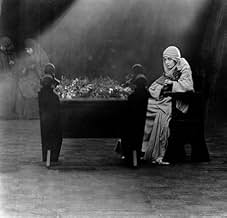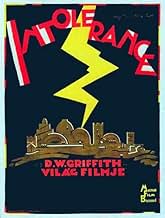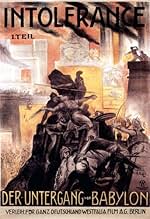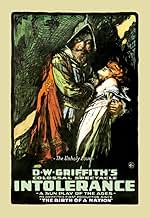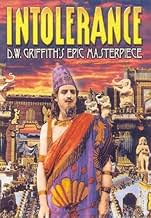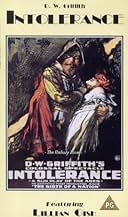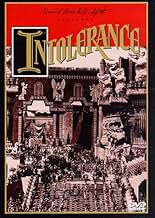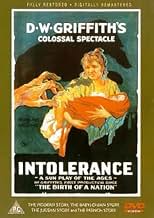Intolérance
Titre original : Intolerance: Love's Struggle Throughout the Ages
- 1916
- Tous publics
- 2h 43min
NOTE IMDb
7,7/10
18 k
MA NOTE
L'histoire d'une jeune femme pauvre, séparée de son mari et de son bébé à cause de préjugés, se mêle à d'autres récits d'intolérance issus d'autres époques.L'histoire d'une jeune femme pauvre, séparée de son mari et de son bébé à cause de préjugés, se mêle à d'autres récits d'intolérance issus d'autres époques.L'histoire d'une jeune femme pauvre, séparée de son mari et de son bébé à cause de préjugés, se mêle à d'autres récits d'intolérance issus d'autres époques.
- Réalisation
- Scénario
- Casting principal
- Récompenses
- 2 victoires au total
F.A. Turner
- The Dear One's Father
- (as Fred Turner)
Julia Mackley
- Uplifter
- (as Mrs. Arthur Mackley)
John P. McCarthy
- Prison Guard
- (as J.P. McCarthy)
Avis à la une
This silent film by director D.W. Griffith is well known to serious movie buffs and historians, but not to today's general public. I doubt that a lot of people these days would have the patience to sit through a film that contained three hours of silence. Nevertheless, the film's technical innovations inspired filmmakers in the 1920's and later, particularly in Russia and Japan. It also inspired filmmakers in the U.S., including Cecil B. DeMille and King Vidor. For this reason, and for other reasons, "Intolerance" is an important film.
The film's four interwoven stories, set in four different historical eras, are tied together thematically by the subject of "intolerance", a word which could be accurately interpreted today as "oppression", "injustice", "hate", "violence", and mankind's general inhumanity.
Griffith's narrative structure, though innovative, is uneven, because he gives more screen time to two of the four stories (the "modern" and the "Babylonian"). Equal time for three stories, thus deleting the fourth, might have worked better.
To me, the Babylonian story is the most interesting one because of its more complete coverage, and because of its elaborate costumes and spectacular sets. Even though there is no script, the viewer can easily discern the plot, which suggests that some of today's films might be just as effective, or more so, if screenwriters would downsize the dialogue.
What "Intolerance" offers most of all to contemporary viewers is a sense of perspective. Someone once said that despite the enormous advances in technology, society itself has advanced not at all. That may be true. In the eighty plus years since the film was released, technical advances in film-making have been obvious and impressive. But we are still plagued with the same old human demons of oppression, injustice, hate, violence, and ... intolerance.
The film's four interwoven stories, set in four different historical eras, are tied together thematically by the subject of "intolerance", a word which could be accurately interpreted today as "oppression", "injustice", "hate", "violence", and mankind's general inhumanity.
Griffith's narrative structure, though innovative, is uneven, because he gives more screen time to two of the four stories (the "modern" and the "Babylonian"). Equal time for three stories, thus deleting the fourth, might have worked better.
To me, the Babylonian story is the most interesting one because of its more complete coverage, and because of its elaborate costumes and spectacular sets. Even though there is no script, the viewer can easily discern the plot, which suggests that some of today's films might be just as effective, or more so, if screenwriters would downsize the dialogue.
What "Intolerance" offers most of all to contemporary viewers is a sense of perspective. Someone once said that despite the enormous advances in technology, society itself has advanced not at all. That may be true. In the eighty plus years since the film was released, technical advances in film-making have been obvious and impressive. But we are still plagued with the same old human demons of oppression, injustice, hate, violence, and ... intolerance.
Four storylines are followed. The first is set in the modern world, where The Dear One (Mae Marsh) and her beloved The Boy (Bobby Harron) are struggling to survive. He loses his job due to union striking after a pay cut mandated so that the company boss can fund his sister's charity work. That same charity takes away the Dear One's child, citing neglect, as the Boy is sent to jail after resorting to crime.
The Biblical "Judean" story recounts how intolerance led to the crucifixion of Jesus. This sequence is the shortest of the four.
The third story details the events of the St. Bartholomew's Day Massacre of 1572 where Huguenot protestants were killed under orders of the Catholic royalty.
The fourth story is set in ancient Babylon, and deals with a religious struggle between different sects that leads to their conquest by the Persians.
Griffith's masterpiece is a marvel of narrative and structural complexity for the time, and the Babylon scenes are truly awe-inspiring in their scope and ambition. The story, in which instances of "intolerance" are illustrated throughout the ages, is a bit muddled and more than a little pretentious, but the visualization is second-to-none.
It's been put forth that Griffith made this as a sort of apologia for the racial insensitivity of his previous mega-hit The Birth of a Nation, but Griffith scholars disagree, and say that Griffith was never ashamed by the racist nature of his last movie, and that the intolerance that he was speaking out against was that which had been directed at him over that film (shades of our current political climate).
Regardless, this ended up being the most expensive film ever made up to that point, and was a major flop at the box office, from which Griffith never really recovered. The film now stands as a colossal achievement, and a precursor to historical epics to come. There are various versions in circulation.
The Biblical "Judean" story recounts how intolerance led to the crucifixion of Jesus. This sequence is the shortest of the four.
The third story details the events of the St. Bartholomew's Day Massacre of 1572 where Huguenot protestants were killed under orders of the Catholic royalty.
The fourth story is set in ancient Babylon, and deals with a religious struggle between different sects that leads to their conquest by the Persians.
Griffith's masterpiece is a marvel of narrative and structural complexity for the time, and the Babylon scenes are truly awe-inspiring in their scope and ambition. The story, in which instances of "intolerance" are illustrated throughout the ages, is a bit muddled and more than a little pretentious, but the visualization is second-to-none.
It's been put forth that Griffith made this as a sort of apologia for the racial insensitivity of his previous mega-hit The Birth of a Nation, but Griffith scholars disagree, and say that Griffith was never ashamed by the racist nature of his last movie, and that the intolerance that he was speaking out against was that which had been directed at him over that film (shades of our current political climate).
Regardless, this ended up being the most expensive film ever made up to that point, and was a major flop at the box office, from which Griffith never really recovered. The film now stands as a colossal achievement, and a precursor to historical epics to come. There are various versions in circulation.
I first saw this picture as a teenager some thirty years ago. I had no idea what to expect; all I knew was the famous still of Belshazzar's feast which has become one of the best known icons depicting the extravagance of crazy old Hollywood. But I was astounded and bowled over by what I saw. I will make no attempt at a plot synopsis here, since several other reviewers on this site have done so. Most readers already know that Griffith set out to tell four separate stories, laid in four widely spaced historical periods, and that he intercut freely between them, increasing the tempo as the film proceeded, and attempted to bring all four to a climax simultaneously. Clearly he bit off more than he, or anybody, could chew; but the fact that the limits of what cinema could do were being pushed so hard so early is what fascinated me then, and still fascinates me now. I wish to heaven that college film courses would just blow off "Birth of a Nation" and consign it to the oblivion it largely deserves, and show "Intolerance" instead, for this indeed is Griffith's monument, despite its poor state of repair; and at the risk of being technical I would like to address this. I have noticed that the one negative comment running most consistently through the reviews posted on this website is the relative lack of weight given to the French and Judaean sequences relative to the Modern and Babylonian narratives. This is largely the fault of the movie's checkered preservation history. When "Intolerance" failed to make huge sums at the box office, Griffith released the Babylonian and Modern stories as individual features in 1919, reshooting some scenes along the way. He cut up the original negative (gasp!) to do this, and by the time he decided to reassemble the whole movie in 1926, it turned out that all the king's horses and all the king's men couldn't quite put Humpty Dumpty back together again. There was never a shooting script, or a written continuity; Griffith kept the whole thing in his head, and moreover could never stop tinkering with it while it was in release! Consequently, while the Babylonian and Modern stories have survived largely intact, the French and Judaean episodes were depleted by about half. So when we see it now we must recognize that we are viewing a broken sculpture. The movie is a restorer's nightmare; almost a third of its 2000- plus shots exist in variant versions, and the captions were rewritten more than once. But, broken as it is, it's still magnificent. There has never been, and will never again be, anything like it. It has all of Griffith's inconsistencies: subtle and naturalistic acting from Mae Marsh and Robert Harron as the luckless couple in the Modern Story are seen cheek by jowl with outrageous mugging by Walter Long as the Musketeer of the Slums, or Josephine Crowell's Catherine de Medici in France; but no masterpiece on this scale is ever consistent, after all. I love Connie Talmadge's Mountain Girl from Babylon; smart, funny and crazy. Other favorites: Tully Marshall as the villainous Priest of Bel; Seena Owen as the Princess beloved, my personal nomination for Most Fabulous Body of the Hollywood 1910s, never mind the deranged costumes; Alfred Paget as a genuinely humane Belshazzar; Howard Gaye as a believable and totally unforced Jesus. Everything the silent screen of 1916 could do, good, bad, subtle, overblown, crazy or glorious is embodied here; and Griffith never rode so high again. The most satisfactory version currently available, in my opinion, is the Kino on Video edition on vhs and dvd, the one illustrated when you first call the picture up on this site. There are some problems and a few missing bits that I take exception to, but overall this is the version that first time viewers should try.
I saw a four hour, ten minute version of this as the University of Chicago's Ida Noyes Hall in February, 1993 -- restored with stills and copyright photos, with a new score by Gillian Anderson, featuring the composer conducting the University Symphony Orchestra -- what an experience!
And where, oh where, is this restored version to be seen today?
Somebody get on the copyright owner's case to release the 4:10 version, with Gillian Anderson's score!
This fine film, possibly the quintessential Griffith, has been in the shadow of the notorious Birth of a Nation too long. (Of course, without Birth of a Nation's controversy, this might never have been made). Intolerance has more spectacle than Birth, far more "speaking" parts (if that's not an oxymoron, I don't know what is!), and is far more PC -- but not in a negative way.
See it, in any form you can!
And where, oh where, is this restored version to be seen today?
Somebody get on the copyright owner's case to release the 4:10 version, with Gillian Anderson's score!
This fine film, possibly the quintessential Griffith, has been in the shadow of the notorious Birth of a Nation too long. (Of course, without Birth of a Nation's controversy, this might never have been made). Intolerance has more spectacle than Birth, far more "speaking" parts (if that's not an oxymoron, I don't know what is!), and is far more PC -- but not in a negative way.
See it, in any form you can!
This mammoth production and DW Griffith's 1916 masterpiece was his followup to The Birth of a Nation. Intolerance blends 4 stories of historical intolerance as a warning against the current-day evils of war. The French and Judean stories are OK. The Babylonian and Modern stories are spectacular. Where Griffith experimented with closeups and intercutting stories in Birth of a Nation, these techniques are mastered in Intolerance. Griffith also continues his incredible eye for composition and scenery and costumes in this epic film.
The sets and costumes for the Babylonian story are among the best in film history. And the battle scenes equal anything in Birth of a Nation. Griffith's Babylonian set is so huge it allows for horse-drawn chariots to ride side by side on the road at the top of the towering walls. The camera shot that shows the chariots and the battle many stories below is astounding. There is also the famous camera shot that slowly moves closer and closer the the city steps and gates where hundreds of dancers perform a pagan production number. Just amazing.
The emotional oomph of this film comes from the modern story where a young couple living in a tenement apartment almost gets destroyed by society do-gooders. The intercutting of scenes here is masterful as the rescuers race to save the hero who is about to be hanged. Melodrama to be sure, but in a form never seen before 1916.
And as usual Griffith assembles a terrific cast and elicits great performances from many of them.
Constance Talmadge plays the cinema's first feminist heroine as the Mountain Girl in the Babylonian story. She's wonderful as the saucy girl who eats onions while on the block to be sold as a slave. As the men come near to examine her (she's dressed in a pelt) she shakes her onions at them and kicks at them. Hilarious. The story is complicated but she overhears a plot to attack the city and the ruler (who set her free) she adores. Great scenes of Talmadge racing a chariot through the desert. Great battle scenes that are unforgettable. Great orgy scenes. This is just a wonderful story that is so eye-filling, you have to watch it several times to take everything in.
The modern story boasts a perfect performance by Mae Marsh as the "Dear One." Robert Harron is the husband, and Miriam Cooper (very underrated) is the "bad girl." One of the most harrowing scenes I can remember is when the "do-gooders" (headed by Vera Lewis) come to take Marsh's baby after Harron is falsely arrest for murder. Marsh is so realistic in this frenzied scene that your heart just stops. Harron is also excellent as the hapless boy who gets framed for murder. The editing of this arc of the film sets the standard for decades to come.
Intolerance must be seen by any serious film buff. It's a long film but is unforgettable. The cast list is impressive and includes the above-mentioned Constance Talmadge, Mae Marsh, Robert Harron, Miriam Cooper, Lillian Gish, Vera Lewis, Ralph Lewis, Douglas Fairbanks, Bessie Love, Wallace Reid, Elmo Lincoln, Elmer Clifton, Mary Alden, Constance Collier, Carmel Myers, Erich von Stroheim, Donald Crisp, Carol Dempster, Marguerite Marsh, Tully Marshall, Natalie Talmadge, Alma Rubens, Seena Owen, Margery Wilson, Eugene Palette, Ethel Grey Terry, Owen Moore, Alfred Paget, Joseph Henabery, Josephine Crowell, Ruth St. Denis, Ted Shawn, Mildred Harris, Walter Long, Sam De Grasse, Monte Blue, Kate Bruce, Nigel De Brulier, Pauline Starke, Lillian Langdon, and future directors King Vidor, Frank Borzage, and Tod Browning!
The sets and costumes for the Babylonian story are among the best in film history. And the battle scenes equal anything in Birth of a Nation. Griffith's Babylonian set is so huge it allows for horse-drawn chariots to ride side by side on the road at the top of the towering walls. The camera shot that shows the chariots and the battle many stories below is astounding. There is also the famous camera shot that slowly moves closer and closer the the city steps and gates where hundreds of dancers perform a pagan production number. Just amazing.
The emotional oomph of this film comes from the modern story where a young couple living in a tenement apartment almost gets destroyed by society do-gooders. The intercutting of scenes here is masterful as the rescuers race to save the hero who is about to be hanged. Melodrama to be sure, but in a form never seen before 1916.
And as usual Griffith assembles a terrific cast and elicits great performances from many of them.
Constance Talmadge plays the cinema's first feminist heroine as the Mountain Girl in the Babylonian story. She's wonderful as the saucy girl who eats onions while on the block to be sold as a slave. As the men come near to examine her (she's dressed in a pelt) she shakes her onions at them and kicks at them. Hilarious. The story is complicated but she overhears a plot to attack the city and the ruler (who set her free) she adores. Great scenes of Talmadge racing a chariot through the desert. Great battle scenes that are unforgettable. Great orgy scenes. This is just a wonderful story that is so eye-filling, you have to watch it several times to take everything in.
The modern story boasts a perfect performance by Mae Marsh as the "Dear One." Robert Harron is the husband, and Miriam Cooper (very underrated) is the "bad girl." One of the most harrowing scenes I can remember is when the "do-gooders" (headed by Vera Lewis) come to take Marsh's baby after Harron is falsely arrest for murder. Marsh is so realistic in this frenzied scene that your heart just stops. Harron is also excellent as the hapless boy who gets framed for murder. The editing of this arc of the film sets the standard for decades to come.
Intolerance must be seen by any serious film buff. It's a long film but is unforgettable. The cast list is impressive and includes the above-mentioned Constance Talmadge, Mae Marsh, Robert Harron, Miriam Cooper, Lillian Gish, Vera Lewis, Ralph Lewis, Douglas Fairbanks, Bessie Love, Wallace Reid, Elmo Lincoln, Elmer Clifton, Mary Alden, Constance Collier, Carmel Myers, Erich von Stroheim, Donald Crisp, Carol Dempster, Marguerite Marsh, Tully Marshall, Natalie Talmadge, Alma Rubens, Seena Owen, Margery Wilson, Eugene Palette, Ethel Grey Terry, Owen Moore, Alfred Paget, Joseph Henabery, Josephine Crowell, Ruth St. Denis, Ted Shawn, Mildred Harris, Walter Long, Sam De Grasse, Monte Blue, Kate Bruce, Nigel De Brulier, Pauline Starke, Lillian Langdon, and future directors King Vidor, Frank Borzage, and Tod Browning!
Le saviez-vous
- AnecdotesDuring filming of the battle sequences, many of the extras got so into their characters that they caused real injury to one another. At the end of one shooting day, a total of 60 injuries were treated at the production's hospital tent.
- GaffesOne of the early title cards in the Judean sequence refers to Jesus having been from "the carpenter shop in Bethlehem". Though he was born in Bethlehem, he worked with his father in a carpenter shop in Nazareth, which is why he was known as Jesus of Nazareth.
- Citations
Intertitle: When women cease to attract men, they often turn to reform as a second option.
- Crédits fousConstance Talmadge is credited as 'Georgia Pearce' for her performance as Marguerite de Valois in the French Story. She is credited under her own name in the role of The Mountain Girl in the Babylonian Story.
- Versions alternativesThe movie was officially restored in 1989 by Kevin Brownlow and David Gill for Thames Television. It was transferred from the best available 35mm materials, color-tinted per D.W. Griffith's intent, and contains a digitally recorded orchestral score by Carl Davis. This 176-minute version was released on video worldwide, but has never been telecast in the U.S.
- ConnexionsEdited into La Chute de Babylone (1919)
Meilleurs choix
Connectez-vous pour évaluer et suivre la liste de favoris afin de recevoir des recommandations personnalisées
- How long is Intolerance?Alimenté par Alexa
Détails
Box-office
- Budget
- 385 907 $US (estimé)
- Durée2 heures 43 minutes
- Mixage
- Rapport de forme
- 1.33 : 1
Contribuer à cette page
Suggérer une modification ou ajouter du contenu manquant


